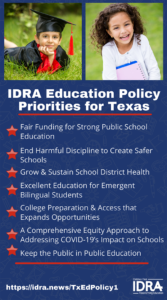• Thomas Marshall • IDRA Newsletter • February 2021 •
 The digital divide in the United States impacts millions of people. And although the problem is significant in rural communities, it exists across the country. Three-fourths of the 20 million U.S. households that still lack home broadband or mobile data connections live in urban areas, not remote rural regions, and are very likely low-income (NDIA, 2019).
The digital divide in the United States impacts millions of people. And although the problem is significant in rural communities, it exists across the country. Three-fourths of the 20 million U.S. households that still lack home broadband or mobile data connections live in urban areas, not remote rural regions, and are very likely low-income (NDIA, 2019).
For students, the digital divide affects their online academic engagement and learning opportunities. In Texas, more than 2 million households do not have access to high-speed Internet.
The COVID-19 pandemic exacerbates the problem. Texas Education Agency reports that more than 600,000 Texas public school students – one in 10 students – did not complete assignments or respond to teacher outreach in spring 2020 as the pandemic began. Schools lost touch with Black students and Latino students at over twice the rate of white students. (TEA, 2020)
The state’s experience with remote schooling due to COVID-19 demonstrates clearly that much needs to be done. Without broadband Internet access, students and families cannot connect online with their schools. Students cannot access teacher materials, complete their homework, or connect to instruction and class discussions virtually. The lack of broadband access disproportionately affects students of color and students in families with low-incomes (Bauerly, et al., 2019).
The digital divide has four components: broadband connectivity, access to a consistent Internet-capable device, digital literacy about how to use Internet resources responsibly, and family engagement in online education.
Broadband Infrastructure Needed
Broadband refers to always-on, high-speed Internet access, whether obtained through cable, fiber, wireless, satellite or a digital subscriber line. The Federal Communications Commission (FCC) specifies broadband as 25 megabits per second (mbps) download speed and 3 mbps upload speed (25/3 mbps) (Connected Nation Texas, 2020).
Texas is one of only six states that does not have a state broadband plan (Pew Charitable Trusts, 2019). In 2019, the Texas Legislature gave the issue some attention by passing three measures related to broadband.
- The Legislature approved Senate Bill 14 in 2019 to ensure broadband infrastructure expands deeper into rural Texas through the help of Texas electric cooperatives.
- The Legislature approved House Bill 2422 relating to the coordination of certain broadband projects by the Texas Department of Transportation. It encourages state transportation and Internet providers to install, upgrade and maintain broadband alongside ongoing state highway construction.
- The Legislature created the Governor’s Broadband Development Council to study and identify ways to provide Internet access to underserved areas of Texas. The council submitted in November 2020 a report with recommendations for the 2021 legislative session to: create a state broadband plan; establish a state broadband office; and develop a state broadband funding program to incentivize deployment in unserved areas.
 The state should move forward substantially to solve this problem by creating a permanent broadband infrastructure that includes connecting high-speed Internet to urban and rural communities. The plan should incorporate perspectives of key stakeholders at the local level to oversee implementation.
The state should move forward substantially to solve this problem by creating a permanent broadband infrastructure that includes connecting high-speed Internet to urban and rural communities. The plan should incorporate perspectives of key stakeholders at the local level to oversee implementation.
Student and Family Engagement Must be Robust
Within a new plan for broadband, lawmakers should create a robust, positive student and family engagement strategy. The plan needs clear steps on how to engage with families, especially those who have been adversely affected by the digital divide and disruptions to student learning.
Inequities in student engagement can be addressed by expanding broadband connectivity and ensuring all students have access to appropriate devices. Students need opportunities to learn how to navigate and use the Internet responsibly through digital literacy and digital citizenship school courses on using the Internet regularly and effectively.
Family engagement is integral in this process, which at its best incorporates authentic collaboration with families and community members. For example, IDRA’s Education CAFE program is based on IDRA’s family leadership model that engages families and community members in their school’s policies and practices (learn more at: https://www.idra.org/families-and-communities/education-cafe/).
Community Reinvestment is Required for Sustainability
Texas needs lawmakers to create a system to empower communities to develop their approaches to identify who needs broadband access. A community reinvestment initiative would put the power of establishing access networks into community stakeholders’ hands. The initiative would be a robust economic development tool to increase jobs and empower local entities like school districts to better handle their students’ connectivity issues.
Currently, FCC regulations use census block data to count households with broadband. That data can be inaccurate or old, so local community groups need to be at the center of creating their own data to gain an accurate account of who has broadband and who does not.
Through such programs, local officials can access state broadband funds and, with communities, collect equity-focused data, establish connectivity maps and identify where connectivity is needed most.
Recommendations
As the Texas Legislature convenes through the end of May, IDRA offers recommendations for developing a sustainable, equitable and community-driven plan for state broadband expansion plan to ensure equitable access.
- Create a statewide broadband plan targeted for rural and urban communities. The infrastructure should address education needs of the most vulnerable student populations – students with disabilities, emergent bilinguals (English learner students), students in families with low-income, Black students, and Latino students – across preK-12 schools and higher education.
- Encourage development of community reinvestment systems to increase access to existing broadband networks, promote digital equity and enable schools to access high-speed Internet. Municipalities could apply for grant program funding to establish equitable mapping for communities to identify the lack of broadband access in their area. This would help curb the inaccuracy of dated census block data used in the current broadband mapping.
- Create a robust student and family engagement plan that prioritizes distance and remote learning options to create accessible pathways for engagement that promote digital literacy. The plan would include connectivity, access to devices and a communication system between schools and families.
Both Governor Greg Abbott and Lieutenant Governor Dan Patrick included broadband access in their policy priorities for the current legislative session. The digital divide must be taken head-on by Texas lawmakers this session to help close academic gaps for marginalized communities and families.
Resources
Bauerly, B.C., McCord, R.F., Hulkower, R., & Pepin, D. (July 12, 2019). Broadband Access as a Public Health Issue: The Role of Law in Expanding Broadband Access and Connecting Underserved Communities for Better Health Outcomes. The Journal of Law, Medicine & Ethics 47, No. 2, 39-42.
Mulverhill, L. (2019). Texas’ Digital Divide – The State of Broadband in Texas’ Rural Communities. Fiscal Notes. Austin: Texas Comptroller of Public Accounts.
National Digital Inclusion Alliance. (2017). Worst Connected Cities 2017. American Community Survey 1-Year Estimates, Table B28002. Columbus, Ohio: NDIA.
Governor’s Broadband Development Council. (November 2020). 2020 Texas Report. Office of the Governor.
Pew Charitable Trusts. (July 2019). No One Approach Fits All States in Efforts to Expand Broadband Access. State Broadband Policy Explorer. Philadelphia: Pew Charitable Trusts.
Urahn, S.K., & Irwin, M. (February 27, 2020). How States Are Expanding Broadband Access. The Pew Charitable Trusts.
Thomas Marshall is an IDRA Education Policy Fellow. Comments and questions may be directed to him via e-mail at thomas.marshall@idra.org.
Texas is one of only six states that does not have a state broadband plan.
[©2021, IDRA. This article originally appeared in the February 2021 IDRA Newsletter by the Intercultural Development Research Association. Permission to reproduce this article is granted provided the article is reprinted in its entirety and proper credit is given to IDRA and the author.]



